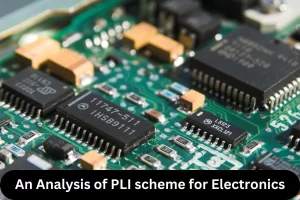ForumIAS announcing GS Foundation Program for UPSC CSE 2025-26 from 27th May. Click Here for more information.

Source: The post India want to boost the electronics-component manufacturing industry through a PLI scheme has been created, based on the article “Transforming manufacturing: Dependence on PLI should be contained” published in “Business standard” on 9th May 2024.
UPSC Syllabus Topic: GS Paper 3-Economy-Changes in industrial policy and their effects on industrial growth.
News: The Ministry of Electronics and Information Technology wants to boost the electronics-component manufacturing industry through a PLI scheme. An Analysis of PLI scheme for Electronics
For details information on an analysis of PLI (production–linked incentive) scheme read this article here
Why does India want to boost the electronics–component manufacturing industry through a PLI scheme?
Enhance Production Capacity: The Ministry aims to create a $75 billion component ecosystem over five years to increase production capacity and make electronics manufacturing cost-effective.
Global Strategy Alignment: Amid rising US-China tensions, India seeks to be part of the China-plus-One strategy, offering a manufacturing alternative for global corporations.
Subsidies as Incentive: The PLI scheme offers subsidies of 4-6% to attract investment and expand domestic manufacturing.
Mixed Success: While mobile phone manufacturing, particularly Apple’s iPhones, has seen some success, most components are still produced abroad. Companies like Wistron and Pegatron have exited the market.
What are the issues with the PLI scheme?
Limited Investment: Investment hasn’t met expectations in sectors like solar panels, automobiles, and textiles, which were expected to benefit from the PLI scheme.
Failure to Create Jobs: The scheme hasn’t generated the required employment in labor-intensive industries like textiles, which still struggle with slow investment growth.
Import Dependence: Even for successful mobile phone assembly (e.g., Apple’s iPhones), most components are still imported, reducing domestic production benefits.
Market Interference: The scheme’s subsidies interfere with market operations and raise bureaucratic control.
Low Utilization: Actual spending on the PLI scheme remains a fraction of the planned budget.
What should be done?
Avoid Over–Reliance on Subsidies: As economist Arvind Panagariya pointed out, PLI isn’t suitable for all sectors. Instead, subsidies should be more focused.
For details information on PLI scheme alone would not be enough read this article here
Strengthen Infrastructure and Policy: Improving infrastructure, maintaining low tariffs, and building a skilled workforce are essential for long-term success.
Study Past Results: The government should analyze the effectiveness of the PLI scheme before expanding it to new sectors.
Question for practice:
Examine how the issues and limitations of the PLI scheme impact India’s goals for boosting electronics-component manufacturing.



